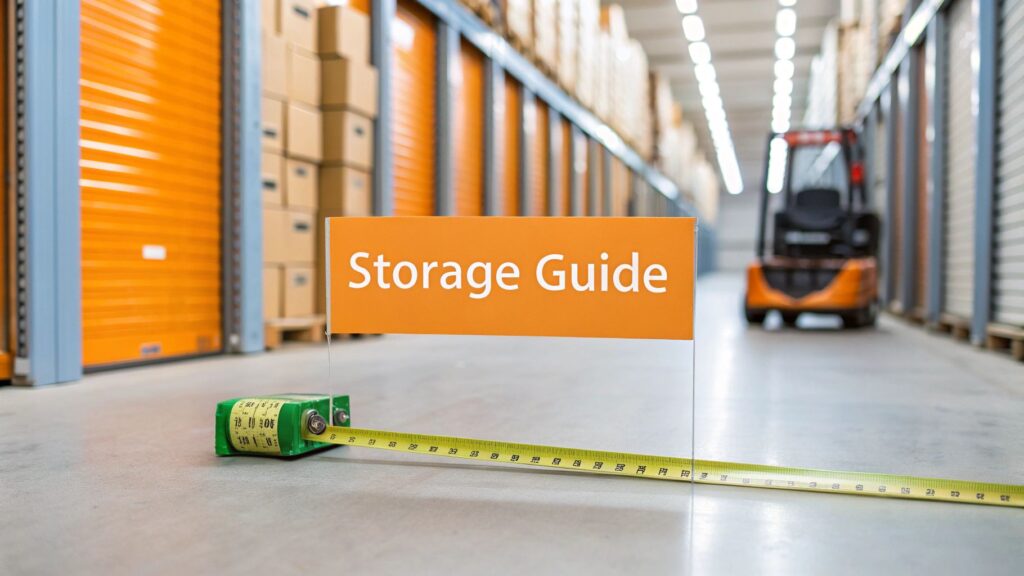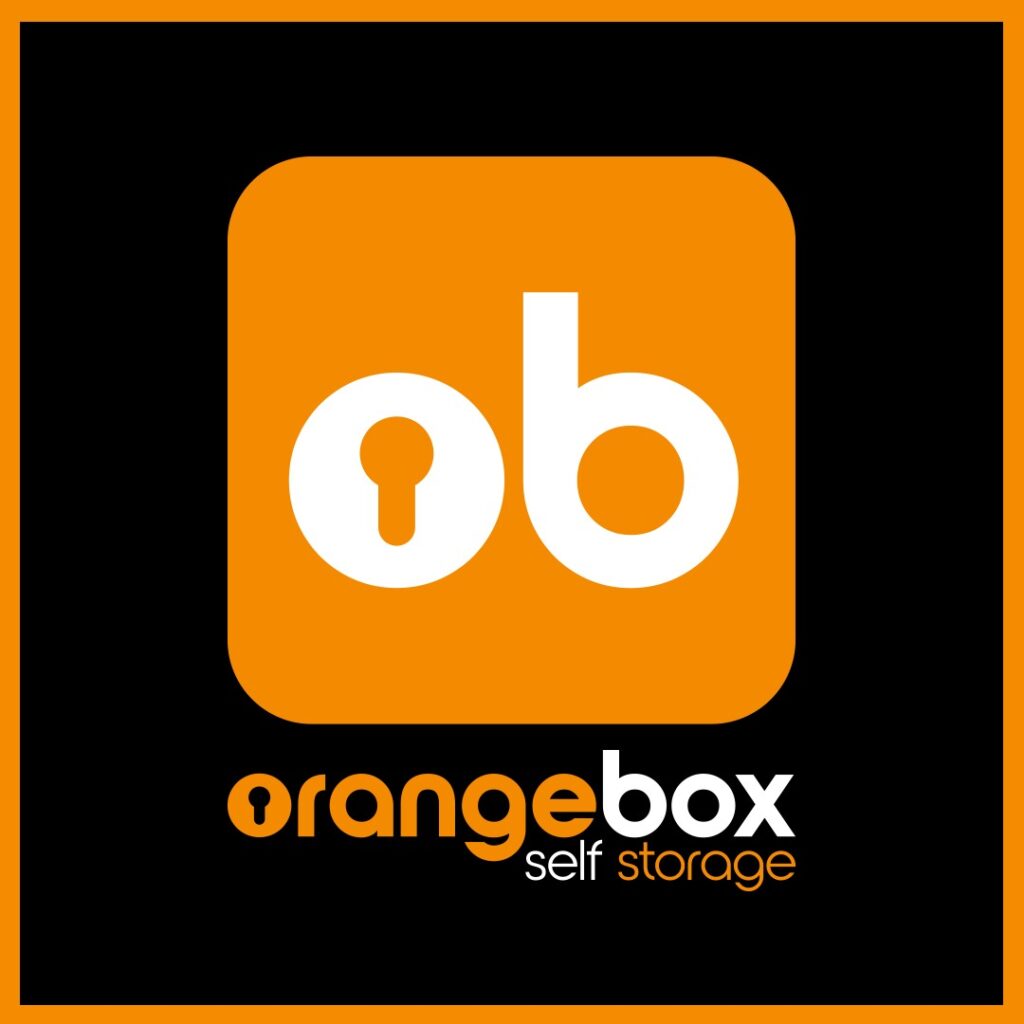Figuring out what size storage unit you need can feel like a bit of a puzzle. It’s easy to get lost in the numbers and end up either paying for space you don’t need or, even worse, finding out the unit you’ve rented is just too small.
This guide is here to take the guesswork out of it. We're going to give you the confidence to pick the right size the first time, without any of the stress.
Find Your Perfect Storage Unit Size Instantly
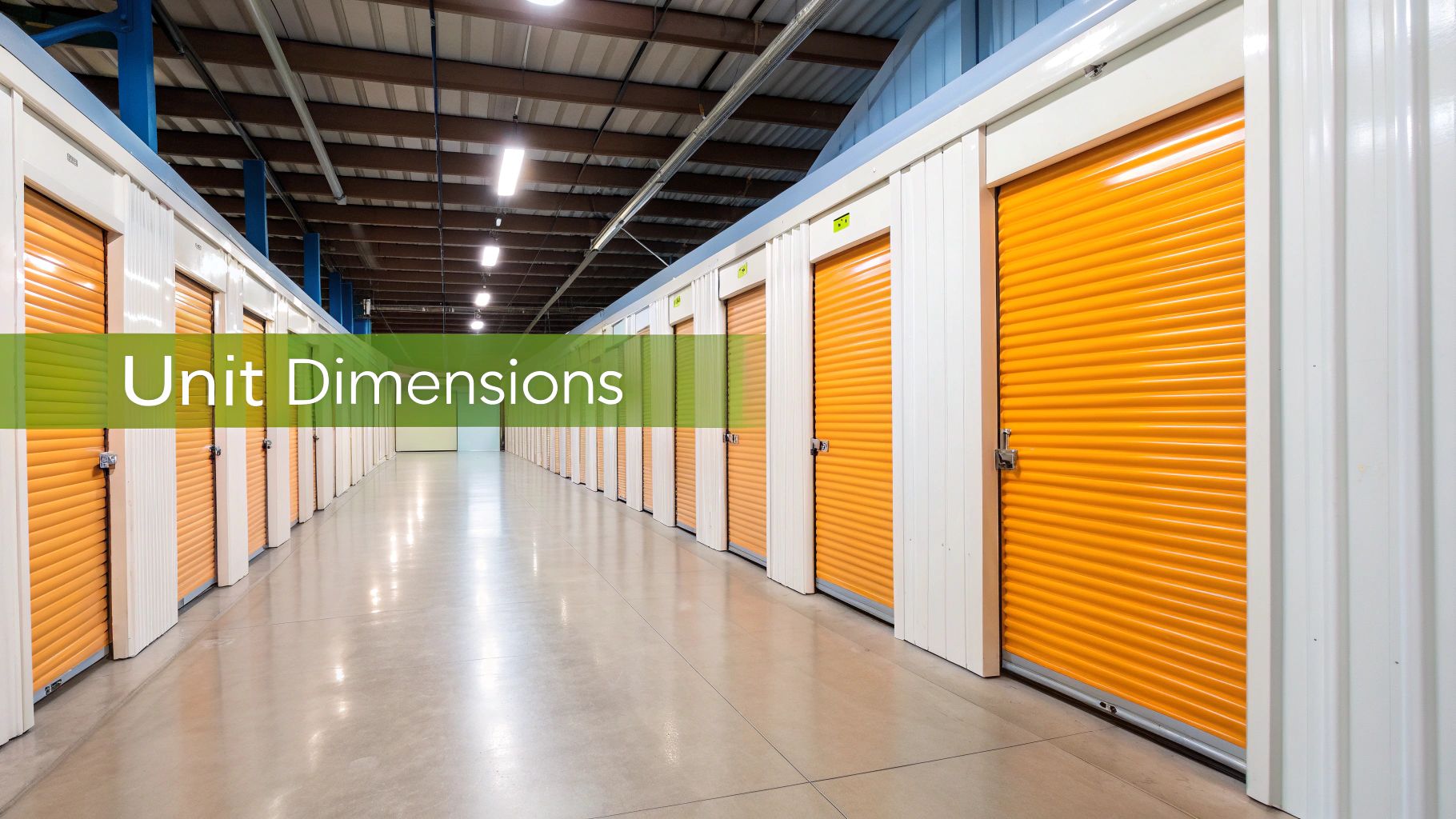
The trick is to stop thinking in abstract measurements and start thinking in real-world terms. After all, you already know a duvet doesn’t belong in a filing cabinet. The same kind of common sense applies here.
We'll help you connect a size like ‘50 sq ft’ to something you can actually picture, like the contents of a studio flat. This way, you’re not just renting a box; you’re choosing the right home for your belongings.
Quick Start Your Selection
Before we get into the nitty-gritty of exact dimensions, let’s get our bearings. The key is to match the scale of your storage needs—whether you're clearing out a spare room or packing up an entire house—with a standard unit size. Getting this right from the start makes everything else much simpler.
To make things even easier, the summary table below is your perfect starting point. It's a simple, at-a-glance reference to help you quickly figure out which category of unit is the best fit for you.
Quick Storage Size Reference
Here's a straightforward breakdown matching common storage needs to standard unit sizes and what they can typically hold.
| Unit Size (Feet) | Roughly Equivalent To | Best For Storing |
|---|---|---|
| 5×5 ft | A large walk-in wardrobe | Seasonal items, boxes, small furniture |
| 10×10 ft | A standard single garage | Contents of a one or two-bedroom flat |
| 10×20 ft | A spacious double garage | Contents of a three-bedroom house |
Think of this table as your cheat sheet. It gives you a solid idea of where to begin your search and helps you narrow down the options without getting overwhelmed.
Visualising Storage Unit Sizes with Real World Analogies
Numbers on a page, like ‘25 sq ft’ or ‘100 sq ft’, don’t always paint the clearest picture. Let’s be honest, it’s hard to know exactly what you’re getting. The key to cracking any storage unit size guide is to translate those abstract dimensions into familiar, everyday spaces you already know. It turns a confusing decision into a far more intuitive one.
Instead of just guessing and hoping for the best, let’s connect these numbers to something real. It's the simplest way to build a strong mental picture of just how much space you're actually renting.
From Wardrobes to Garages: A Simple Comparison
Let’s start small. A 5×5 ft unit (25 sq ft) is best imagined as a large walk-in wardrobe or even a decent-sized garden shed. It’s the perfect spot for stashing seasonal items you don’t need year-round, a few dozen boxes of documents, or small pieces of furniture like a bedside table and a lamp.
Moving up a notch, a 10×10 ft unit (100 sq ft) gives you a lot more breathing room. Think of it like a standard single-car garage. This size is incredibly popular because it can comfortably hold the entire contents of a one or two-bedroom flat, including big appliances, sofas, and bedroom furniture. It really hits the sweet spot for people in the middle of a move or a home renovation.
The real game-changer in storage is remembering to use the vertical space. Most units have a ceiling height of around 8 feet, which is probably the most underutilised asset you have. Stacking boxes smartly and standing furniture on its end can dramatically increase what you can fit in, potentially letting you rent a smaller, cheaper unit.
It's clear that the need for this kind of flexible space is growing. The UK self-storage industry is booming, with a market turnover of around £1.2 billion. The total available floorspace recently shot up by 7.2% in just one year, which shows just how strong the demand is from both people and businesses looking for adaptable storage. You can explore more data on this industry growth to see the trends for yourself.
The Importance of Height and Depth
When you’re picturing your unit, don't just think about the floor space. You're renting the whole three-dimensional box. A tall bookcase or a disassembled bed frame can be stored vertically against a wall, freeing up valuable floor area for everything else. It’s a simple but critical strategy for getting the most out of any storage unit.
The infographic below breaks down how different sizes match up with their ideal uses, helping you map out your needs visually.
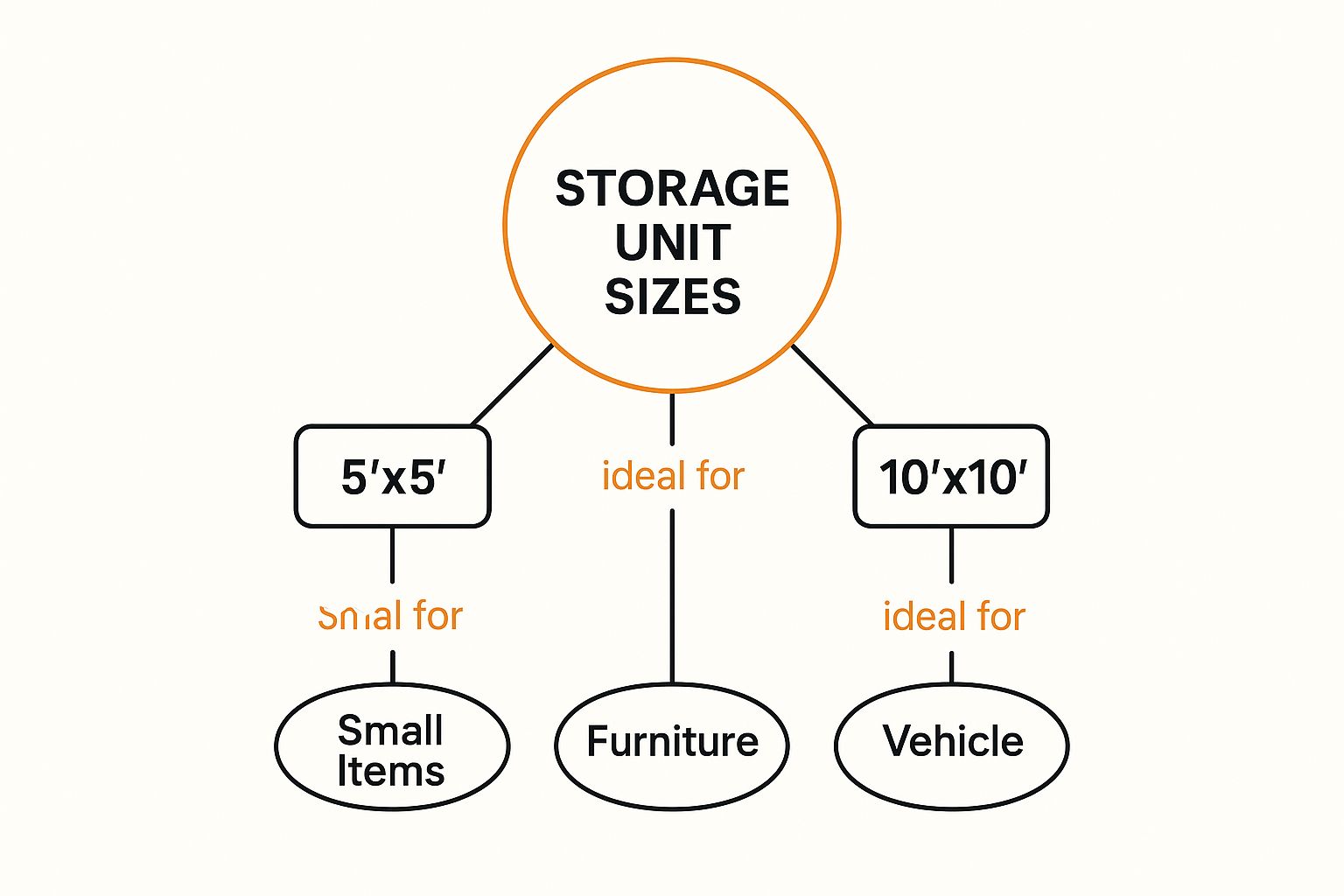
As the visual guide confirms, the smaller units are perfect for boxes and seasonal gear, medium units can handle the furniture from a flat, and the large ones are built for entire households or even vehicles.
For the largest common size, a 10×20 ft unit (200 sq ft), you should be thinking of a spacious double garage. This is a substantial amount of room, designed to hold everything from a three to four-bedroom house. It can easily swallow bulky items like large dining sets, multiple bedroom suites, garden equipment, and even a car or small boat. It’s the go-to option for major life transitions or for businesses needing to store a serious amount of inventory.
A Detailed Breakdown of Common Storage Dimensions
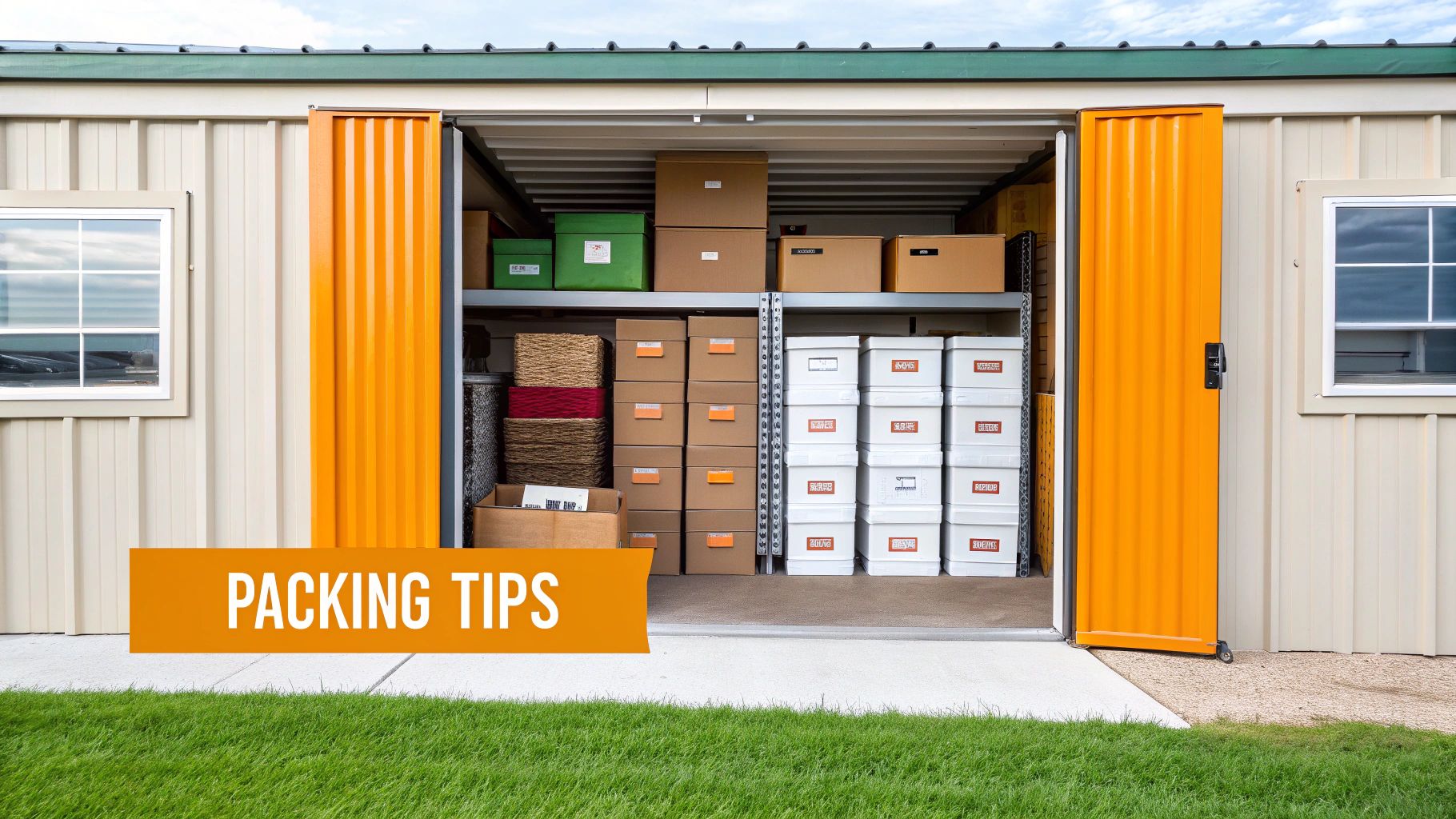
Right, now that we’ve got some handy real-world analogies out of the way, it’s time to get into the nitty-gritty. This guide will walk you through the most common storage unit dimensions, so you can match your stuff to the right space without any guesswork.
Knowing what each size can realistically hold is the key to choosing with confidence. We’ll break down not just the floor space, but what you can actually fit inside, whether you’re clearing out the spare room or storing business stock.
Small Units: The Compact Choices
Small storage units are brilliant when you just need a bit of extra breathing room. They're a budget-friendly choice for stashing the things that are cluttering up your home or office.
-
5×5 ft Unit (25 sq ft)
This is about the size of a large wardrobe. It's spot-on for storing a few dozen standard boxes, seasonal decorations like the Christmas tree, a small desk, or sporting gear like golf clubs. For businesses, it's a great place to archive documents or keep a small stash of marketing materials. -
5×10 ft Unit (50 sq ft)
Picture a large walk-in closet. This unit can usually hold the contents of a studio flat or a single bedroom, including a double bed, a chest of drawers, and several boxes. It's a popular choice for students or anyone needing to clear out a spare room for a new arrival.
These smaller units are incredibly versatile and offer a cost-effective solution for all sorts of situations. They are a core part of our personal storage options, giving you just enough space so you don't end up paying for more than you need.
Medium Units: The All-Rounders
Medium-sized units hit that sweet spot between space and value, which is why they’re one of our most popular choices. They're perfect for everything from moving house to stashing business inventory.
-
10×10 ft Unit (100 sq ft)
Roughly equivalent to a standard single garage, this unit can comfortably take on the contents of a two-bedroom flat. That includes big furniture like sofas, dining sets, and major appliances like a washing machine and fridge. For a business, it’s big enough for a good amount of stock or equipment. -
10×15 ft Unit (150 sq ft)
A bit roomier than a single garage, this unit is great for storing everything from a small two-bedroom house. It has enough space for bulky furniture, several appliances, and plenty of boxes. It's also an excellent option if you have garden furniture or larger hobby equipment to store away.
One of the most common mistakes people make is underestimating just how much stuff they have. It's almost always better to choose a unit that seems a little too big than one that's just a bit too small. That extra room makes packing, and getting to your things later, so much easier.
Large Units: For Maximum Capacity
When you’re looking at storing the contents of an entire family home or a serious amount of business assets, our large units give you the generous space needed to keep everything safe and organised.
-
10×20 ft Unit (200 sq ft)
This is the size of a spacious single garage and it’s our most requested large unit. It can hold all the belongings from a three-bedroom house, including large furniture, countless boxes, and even a car. Businesses often use this size for storing a hefty amount of inventory, tools, or machinery. If you want to get a better feel for how dimensions work, this remodeler's guide to typical cabinet sizes offers some great insights into standardised measurements. -
10×30 ft Unit (300 sq ft)
Offering a massive amount of space, this unit is perfect for a four or five-bedroom house move. It can handle oversized furniture, multiple appliances, garden equipment, and a car with room left over. For commercial use, it's basically a mini-warehouse—ideal for contractors or e-commerce businesses holding large quantities of stock.
To make it even clearer, here’s a detailed table breaking down what you can expect to fit in each unit.
Detailed Storage Unit Capacity
This table provides a quick reference to help you visualise the capacity of our most common unit sizes for both personal and business needs.
| Unit Size (Feet) | Square Feet | Typical Contents (Personal) | Typical Contents (Business) |
|---|---|---|---|
| 5×5 | 25 | Dozen boxes, small furniture, seasonal decor, golf clubs | Archived files, small inventory, marketing materials |
| 5×10 | 50 | Studio flat contents, double bed, chest of drawers, boxes | Excess office furniture, document overflow, booth displays |
| 10×10 | 100 | Two-bedroom flat contents, sofas, dining set, major appliances | E-commerce stock, tools, small machinery, office supplies |
| 10×15 | 150 | Small two-bedroom house contents, garden furniture, bulky items | Contractor equipment, larger inventory, seasonal stock |
| 10×20 | 200 | Three-bedroom house contents, large furniture, appliances, vehicle | Substantial inventory, machinery, palletised goods |
| 10×30 | 300 | Four/five-bedroom house contents, oversized furniture, car | Mini-warehouse, bulk storage, commercial equipment |
Hopefully, this breakdown gives you a much clearer picture of what size will work best for you. Remember, it's always better to have a little extra room to manoeuvre than to be squeezed for space
How to Calculate Your Exact Storage Needs
Moving from a rough estimate to an exact calculation is the secret to getting the right unit without overpaying. Winging it often means you end up with too much space (and a bigger bill) or, even worse, you’re left scrambling for more room on moving day. A bit of planning now saves a world of hassle later.
The good news is, this doesn't have to be complicated. By putting together a quick inventory, you can figure out the exact square footage you need and take all the guesswork out of the decision.
Create Your Master Inventory List
First things first: list everything you plan to store. You don’t need anything fancy; a simple spreadsheet or even a notepad will do the trick. Just go room by room and jot down every single item, from the big three-seater sofa down to the smallest box of books.
To keep it from getting overwhelming, group similar items together. Think in categories like:
- Large Furniture: Sofas, beds, wardrobes, dining tables.
- Appliances: Fridges, washing machines, microwaves.
- Boxes: Group them by size (small, medium, large).
- Miscellaneous: Lamps, mirrors, garden tools, bicycles.
This organised approach helps ensure you don’t forget anything and gives you a clear bird's-eye view of what you're working with. It's an absolute lifesaver when planning a house move, where keeping tabs on everything is half the battle. Our guide on moving home storage has even more tips to make this part of the process a breeze.
The Power of Vertical Space
Don't just think about floor space. Your secret weapon for maximising every square inch—and potentially saving money—is stackability. Most storage units have surprisingly high ceilings, and using that vertical space effectively can often mean you can get away with a smaller, cheaper unit.
Sturdy, same-sized boxes are your best friend here, as they can be stacked high and safely. You can also take things apart, like bed frames and tables, to store them upright against a wall.
Think of it like a game of Tetris. The goal is to fit everything together with as little wasted space as possible. By planning how items will stack and slot together, you can turn a chaotic pile of belongings into a masterpiece of efficiency.
As self-storage becomes more common across the UK, especially in growing markets like the South East and North West, people are getting much smarter about how they use their space. Younger generations, in particular, are finding clever ways to make storage solutions work for their modern lifestyles.
From Inventory to Square Footage
Once your list is complete, it’s time to translate it into a unit size. As a general rule of thumb, you’ll need roughly 25 square feet of storage space for every room’s worth of furniture. So, a typical two-bedroom flat, for example, usually fits quite comfortably into a 100 sq ft unit.
After you have a solid idea of your needs, you can explore comprehensive storage solutions to find a facility that’s the perfect match for your belongings and budget. Taking these simple steps gives you all the information you need to make a confident, informed choice.
Thinking Beyond Square Footage
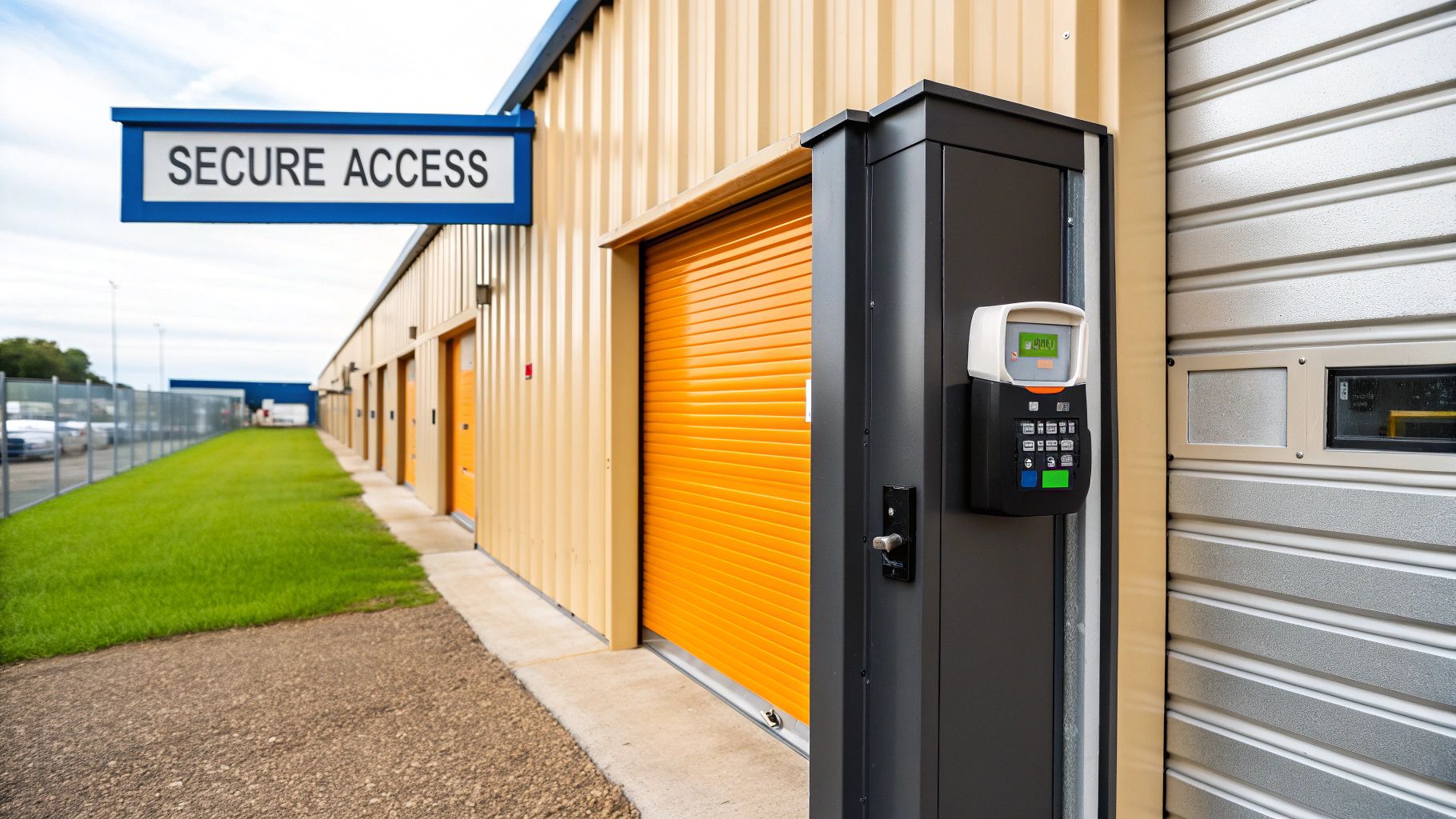
Choosing the right storage unit is about more than just matching dimensions to your belongings. While getting the size right is the perfect starting point, a few other factors can make all the difference in protecting your things and giving you a stress-free experience. Thinking about these details now will save you from a world of headaches later on.
The features a facility offers can be just as crucial as the square footage you rent. From top-notch security to round-the-clock access, these are the details that determine how well a unit really fits your needs.
Protecting Your Valuables with Climate Control
One of the first things to consider beyond size is climate control. A standard unit is perfectly fine for many items, but anything sensitive to temperature and humidity needs an extra layer of protection. Without it, your most prized possessions are left vulnerable.
Imagine your beautiful wooden furniture warping, expensive electronics getting fried by moisture, or treasured documents and photos developing mould. A climate-controlled unit keeps the environment stable, acting as an insurance policy against the famously unpredictable British weather and preventing damage that can’t be undone.
A great storage unit size guide doesn’t just focus on what you can fit inside—it’s about how well your items will be preserved. Opting for climate control is less of a luxury and more of a necessity for anything you couldn't bear to lose.
Security and Access Features
Knowing your belongings are safe and sound offers priceless peace of mind. When you're comparing facilities, look for robust security that goes beyond a simple lock on the door. The essentials you should be checking for include:
- 24/7 CCTV surveillance that keeps a constant eye on the premises.
- Gated access with personal codes to make sure only authorised people can get in.
- Good lighting all around the facility, especially down the corridors and in outdoor areas.
Just as important is accessibility. Check the facility’s access hours to ensure they work with your schedule. Some places offer 24-hour access, which is a lifesaver if you need to grab something or drop items off outside of typical business hours. The number of self-storage units at UK facilities can range from 50 to over 1,000, so larger sites in urban centres often provide more flexible access.
Indoor Units vs Outdoor Drive-Up Containers
Finally, think about what type of unit works best for you. Indoor units, tucked away inside a larger building, offer an extra layer of protection from the elements and are usually where you’ll find climate-controlled options. They're the ideal choice for storing valuable or delicate items.
On the other hand, outdoor drive-up units offer unbeatable convenience when it comes to loading and unloading. You can pull your car or van right up to the door, which makes them perfect for heavy, bulky furniture or if you know you’ll need to pop in and out frequently. To figure out the best fit for your situation, have a look at our detailed guide on indoor vs container storage options.
A Few Final Questions About Storage Sizes
Even with the best storage guide in hand, a few questions always seem to pop up right when you’re about to book. We get it. Choosing the right unit is a big decision, so this final section tackles the most common queries we hear day in and day out.
Think of it as a final checklist to clear up any lingering doubts, from packing hacks to facility rules. Let's get you sorted with complete confidence.
What's the Most Popular Storage Unit Size in the UK?
Hands down, the 10×10 ft (100 sq ft) unit is one of the most popular sizes across the UK. It just hits that sweet spot for versatility, giving you about the same amount of space as a standard single garage.
It’s the go-to size because it can comfortably hold the contents of a two-bedroom flat. This makes it perfect for people moving house or clearing everything out for a major renovation. It’s also a firm favourite for small businesses needing a bit of inventory space without committing to a pricey commercial lease, which is why you’ll find them at most facilities.
How Can I Pack My Unit to Get the Most Space?
Getting the most out of your unit is all about packing smart. The real trick is to think vertically and strategically, turning what could be a jumbled pile of belongings into a neatly organised space.
Here are a few tips that make all the difference:
- Heavy Items Go First: Always place your big, heavy belongings like fridges, washing machines, and sofas at the back of the unit.
- Leave a Walkway: This is a game-changer. Leave a narrow aisle down the centre of your unit. It saves you from the nightmare of having to empty everything just to find one box hiding at the back.
- Stack Like a Pro: Use sturdy, same-sized boxes. They’re much easier to stack high, and placing the heaviest ones at the bottom creates a really stable base.
- Think Vertically: Whenever you can, take furniture apart. Bed frames and tables stored upright against the walls free up a surprising amount of floor space.
The most overlooked asset in any storage unit is its height. Most units are about eight feet tall, and using that vertical space properly often means you can get away with renting a smaller, cheaper unit.
Can I Switch to a Different Size Unit Later On?
Absolutely. One of the best things about self-storage is the flexibility it offers. Most facilities in the UK know that your needs can change, and they’re usually more than happy to help you upsize or downsize.
The process is generally pretty straightforward, but it does depend on whether they have the size you need available at the time. We always suggest having a quick chat with the facility manager beforehand to get the lowdown on their transfer policy, including any notice periods or fees that might apply. That way, you're never stuck paying for a space that no longer works for you.
Are There Things I’m Not Allowed to Store?
Yes, every storage facility has a list of prohibited items. These rules are in place for really important safety, insurance, and legal reasons—they protect your things, other customers’ belongings, and the facility itself.
As a general rule, you can’t store:
- Hazardous Materials: This covers anything flammable, explosive, or corrosive. Think petrol, paint thinners, fireworks, and cleaning chemicals.
- Perishable Goods: Any food items that can spoil are a big no-no. They attract pests, which you definitely don’t want anywhere near your belongings.
- Living Things: It might seem obvious, but you can’t store plants or animals under any circumstances.
- Illegal or Stolen Items: For clear legal reasons, you can't store anything that’s prohibited or hasn't been obtained legally.
It's also worth checking the facility's policy on storing very high-value items, like fine art or jewellery, as they might need specialist insurance. The best advice? Always read your rental agreement for a complete list before you start packing.
Ready to find the perfect storage space without the guesswork? Orange Box Self Storage offers a wide range of sizes to fit every need, from a few boxes to the contents of an entire house. Find your ideal unit online in seconds and book with confidence today.

